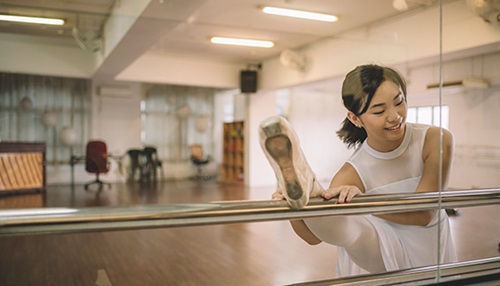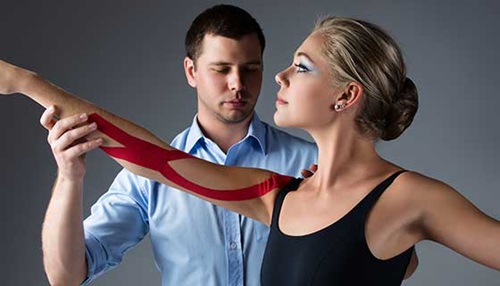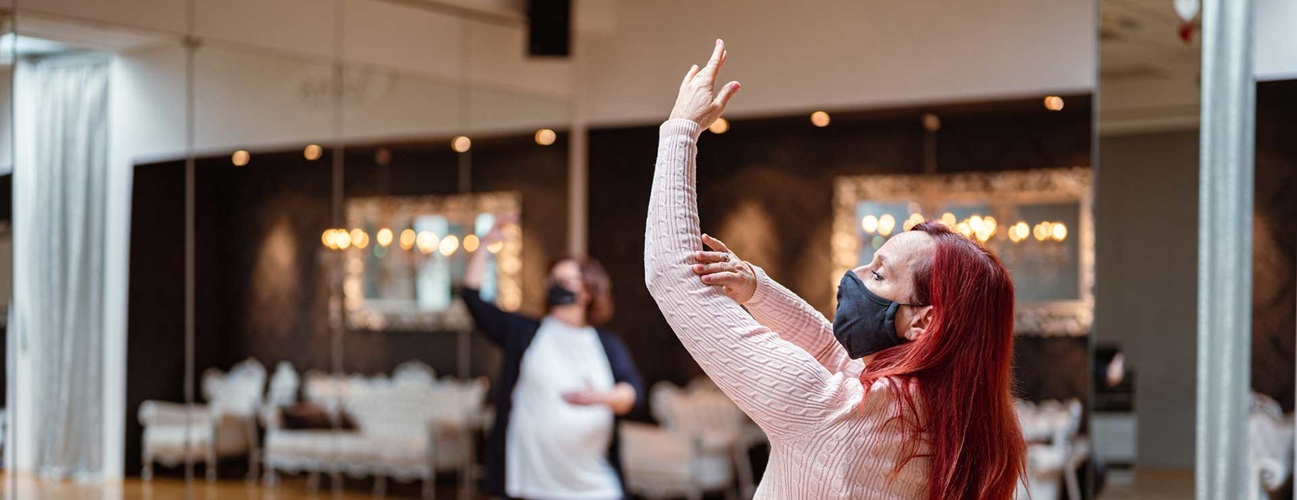Dance Conditioning: Returning to the Studio After Coronavirus Isolation
The COVID-19 pandemic has put many of our social and professional activities on hold, including temporarily closing many dance studios and gyms, forcing dancers to practice at home without proper space and equipment. As dancers prepare to return to the studio and the stage, Johns Hopkins performing arts physical therapy fellow Monique DeLuca shares tips on how to avoid injury while resuming the training routine.
When you are back at the studio, keep in mind that it is important to continue adhering to infection prevention guidelines to protect yourself and others while practicing dance. These guidelines include practicing physical distancing, washing your hands, avoiding touching your face and wearing a mask.
How Coronavirus and Isolation Affect Your Dance Training Routine
Practicing dance moves in a smaller space, such as in your living room or even outside on your deck or porch, has many limitations. It reduces your range of movement, introduces uneven surfaces and obstacles, and usually makes it impossible to train with the same intensity you would in a studio. Not having a large mirror to check your moves also poses a risk of failing to notice and correct poor form.
This modified or restricted practice environment leads to a deconditioning of the body — the body slowly loses its tone and ability to perform the way it did before. “Even if you’ve been training at home, you are likely not moving the same way, and the effects of deconditioning will occur in about four weeks,” says DeLuca.
The body may become deconditioned regarding six physical skills that are important for a dancer — some as fast as one week:
- Agility — Transitioning from one move to another in a dance requires a lot of agility.
- Coordination — Pirouettes and jumping, in general, require much coordination.
- Reaction Time — In a choreographed dance, many positional changes require fast reaction time.
- Balance — Balance is a major component of dance. Some positions, such as standing in a relevé, rely heavily on good balance.
- Power — Dance elements such as petit allegro (jumping steps) require power to lift the body off the floor repeatedly.
- Speed — Crossing the floor and other allegro-type activities depend on speedy implementation.
All of these components work with one another, so a decrease in one could affect another. For example, you can’t achieve optimal reaction time without speed. ”Each of these skills requires a mind-body connection, so you need to be able to efficiently send signals from your brain to your muscles,” says DeLuca.
A major part of deconditioning is neurological deconditioning, as your brain “unlearns” what happens when you dance. Practice and repetition help relearn these patterns until they become second nature, like riding a bicycle.
Common Dance Injuries and Prevention Tips

Our performing arts physical therapists Amanda Greene and Andrea Lasner— answer common questions and provide tips on dance injury prevention.
What to Consider When Returning to Professional Dance After a Break
Start with baseline conditioning at home
“It’s recommended to maintain some of your body's conditioning at home with modified dance classes about three to five days a week with two to three hours of movement, as well as cross-training three days a week,” says DeLuca.
When you have a date to return to the studio, gradually build up the hours you practice daily to your in-studio average, which for professional dancers can be six to eight hours. Once back to the studio, allow yourself a period of two to three weeks to get back to your normal practice hours.
Go at your own pace
Re-conditioning your body takes time, and everyone’s body is different. It will take some dancers longer than others to re-condition and be ready to perform at the level they are used to. “Research has shown that it can take about 12 weeks for an elite athlete to work back up to their previous level of performance after just eight weeks out of practice, and it can take even longer for younger dancers,” says DeLuca. “So be mindful of your body, as well as everyone in your class if you are teaching.”
It’s important to remember that fatigue leads to injury, and being out of practice for a while means fatigue will set in faster. ”It’s vital to have a period of rest — your body gets stronger on recovery/rest days, not on training days,” DeLuca stresses.
Creating a plan that allows for rest and recovery during training periods is called periodization. The goal is to prevent overtraining injuries by starting with a large amount of lower-intensity exercises and ramping up to fewer sets with higher intensity. This way, you are in your top shape before an audition or performance and can wind down for a period of rest afterward. “While there is usually no off-season in dance, the coronavirus has resulted in a long break for many dancers, and plenty of time to prep for competitions and performances,” says DeLuca.
Performing Arts Rehabilitation Program

The Johns Hopkins performing arts rehabilitation program evaluates, treats and educates performing artists, helping them to express their very best in their form of art, whether it’s a hobby or a profession.
Start with simple moves
As you return to your normal dance practice, it is important to think about sequencing — moving from easier skills to more advanced skills. ”Think about the moves you haven’t done at all or not at full range because of the space restrictions — these may take longer to get back to,” advises DeLuca.
It’s especially important to not do too much too quickly when it comes to the moves that require a lot of power, like jumps. In a deconditioned body, smaller muscles will try to compensate for the lack of power in the larger muscles, which may lead to injury because the smaller muscles are not built to carry such strain.
Incorporate fitness training
There are three types of fitness training to bring into the workout that can help improve your dance conditioning:
- Aerobic exercise focuses on cardiovascular conditioning, which may include running, swimming and biking. “The American College of Sports Medicine recommends 20–40 minutes of moderate to vigorous aerobic activity three to five days a week,” says DeLuca. The talk test method lets you easily recognize how difficult your workout is: Moderate workouts allow talking in short sentences, while vigorous workouts only allow a few words.
- Muscular fitness workouts can be broken down into three types: endurance, strength and power.
- Endurance workouts use less weight with shorter periods of rest between repetitions.
- Strength workouts require moderate weight loads with fewer sets and repetitions.
- A power workout focuses on heavy weight loads with very few repetitions to set and much longer rest periods.
Muscular fitness workouts can be done twice per week to maintain conditioning.
- Musculoskeletal flexibility workouts focus on stretching and improving flexibility. There are two types of stretching: static and dynamic.
- During static stretching, you hold a position for a while. It is best done after an activity, when your muscles are warm.
- Dynamic stretching is best before or during activity. You perform a specific movement to stretch the joint’s full movement range.
If you are working out in a gym, make sure that the gym is following CDC guidelines. Remember to wipe down gym equipment before and after use. Keep your mask on, even when you are working out, and practice physical distancing, staying at least six feet from others.
Focus on the whole dancer
Besides deconditioning of the body, other COVID-19 factors may affect performance. The pandemic has placed a lot of pressure on people and has caused not only a health crisis but also mental, sociocultural, economic and emotional stress.
“Especially in the arts world, many people and jobs have been affected,” says DeLuca, “so make sure to check in with yourself and others in your dance studio.” While this may not relieve the cause of the pressure, it helps create a caring and accepting environment. Communicating with other dance professionals, even virtually, can help reduce isolation, and you can gain a workout partner who can help keep you accountable and on track with your practice routine.






